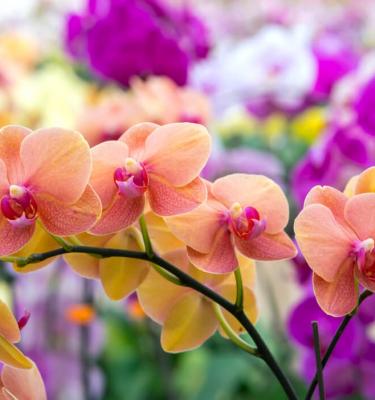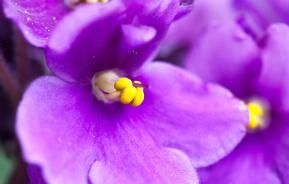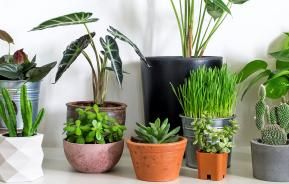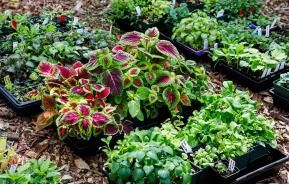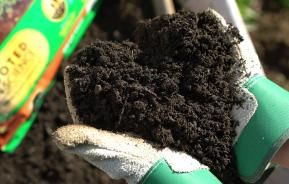The different types of orchids
Most orchids are epiphytic, although some are semi-terrestrial.
Epiphytic orchids
Examples of epiphytic orchids include the widely available ‘Phalaenopsis’, known as the the moth orchid, as well as the highly scented ‘Cattleya’ and ‘Oncidium’ orchids.
Other examples include the ‘Vanda’ orchid, which is prized for its large and extravagant blooms, and is often sold and displayed bare root, as it would naturally grow.
Semi-terrestrial orchids
By contrast, other tropical orchids such as the ‘Paphiopedilum’, or ‘Slipper Orchid’, are semi-terrestrial, meaning their roots do grow down into the soil.
In nature, these orchids would be found growing on the forest floor.
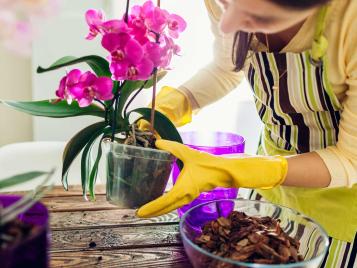
How to grow orchids
Growing orchids from seed
Orchids are grown commercially for their exquisite flowers. They can be grown from seed, but this often involves very specialised equipment, so it’s easier to buy flowering orchids and grow them on.
Flowering orchids - how to grow them at home
You will need the following essential equipment for replanting and growing your orchid at home:
- Orchid feed such as the Miracle-Gro Pump & Feed Orchid
- Watering device or can
- Plant mister
- Plant stakes, supports and clips
- See-through plastic orchid pot
- Orchid fertiliser
- Organic orchid growing medium, like the Miracle-Gro Premium Orchid Compost
- Secateurs
- Decorative pot if desired
It’s worth repotting newly purchased orchids so that you can inspect the roots and the state of the growing medium too. You should also check for signs of pests or any disease.
- Carefully ease the orchid out of its growing pot, and gently remove all the growing medium around the roots. You may choose to rinse the roots under the sink, or soak them for 10 minutes, as hydrated orchid roots are more flexible and less easy to damage.
- The orchid’s aerial roots are usually pale with green tips. Don’t remove these as they are crucial to the plant’s survival. However, do remove dead roots with a sterile cutting tool. The easiest way to tell if a root is dead is to press on it gently. If it feels firm, it’s still alive. If it is mushy or shrivelled, it’s dead and will no longer serve the plant.
- Plant the orchid into a pot either the same size or one size up, ensuring the roots are snug. For this, you will require a plastic orchid pot. Clear pots make caring for orchids easier as you can regularly check the plant’s roots. If you don’t like the look of a plastic pot, you can hide it within a decorative container for display in the home.
- Add the new growing medium a little at a time, tapping the side of the pot so that it falls between the orchid’s roots. Use a specialised orchid growing medium, as traditional soil isn’t suitable for orchids. This is a replacement for soil and gives the orchid support without smothering the roots. Orchid medium mixes may include bark chips, charcoal, sphagnum moss, and coconut husks. They are airy but often organic, holding moisture for the roots to absorb.
- You may also want to fertilise your orchid with a liquid orchid feed, once or twice a month, fertilising more regularly when the flower spikes appear.
- Once flowering is over, you can use clippers to remove the spent flower stalk at the base of the orchid.
Orchids will generally need repotting every two to four years, depending on the species.
How to care for orchids at home
Despite their popularity, some people find they have varying degrees of success when growing and caring for orchids.
In fact, caring for your orchid at home is quite straightforward if you know what type you have, as the required treatment can differ slightly between varieties. As long as you know this, you can create the right environment for your orchid and cater for its particular requirements.
Taking care of orchid types
- Orchids such as Phalaenopsis and Oncidium prefer bright shade or filtered light, as their leaves can burn when exposed to direct sun, especially in hot weather.
- If you have a sunny spot in mind for your orchid, you might consider varieties that grow happily in higher light and heat levels, such as Cattleyas, Vandas and Dendrobiums. Alternatively, you could filter the light source with a blind.
- The majority of orchids thrive in temperatures from 18-25°C (64.4-77 °F). In low temperatures, some orchids, such as Dendrobiums will suffer, or fail to bloom.
Others, such as Cymbidiums and Phalaenopsis, actually need a small dip in temperature to encourage flowering. Whatever the species, it’s best to avoid extreme changes of temperature as this can stress the plant.
Watering orchids - what you need to know
Orchids also benefit from regular watering, especially when in active growth. The frequency of watering required often depends on temperature and humidity. For example, in dry environments with low humidity, orchids will require regular watering.
Let the growing medium and roots get thoroughly wet when watering but ensure excess water escapes. Wipe up any water caught in the leaves of the plant, as sitting water can lead to rot. The easiest watering method is to soak the orchid and its pot in a larger container for five to 10 minutes, before letting water drain away in the sink. Always use tepid water, as hot or cold water can damage the roots.
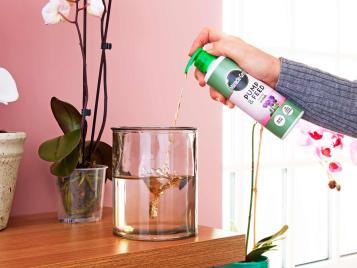
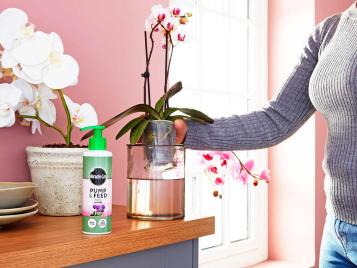
When looking for any signs of dehydration again this will depend on the type of orchid you have. For example:
- Phalaenopsis – check the colour of the roots as they will turn from bright green to silver or grey if dehydrated.
- Oncidium and Cattleya - check to see if the growing medium is dry to the touch.
Ongoing orchid care
Different orchids will have different watering needs, with Phalaenopsis being particularly resilient and able to cope with infrequent watering, while Vandas and Paphiopedilum need higher levels of moisture to thrive.
Orchids take up all their nutrients and moisture through their roots, which in the wild are exposed to air. The health of the roots is crucial to the orchid’s success.
Feeding and regular watering keep orchids healthy and blooming, while regular checks for dead or rotting roots could save the orchid’s life. Adequate ventilation is also vital for good root health. With this in mind, make sure you use a pot with ventilation and drainage holes, and only water the orchid when necessary.
Equipment for looking after orchids
For day to day care, you will need a small watering device and a specialised orchid feed. For regular feeding, a balanced orchid fertiliser is best. If the environment is very dry, a mister may help to raise the humidity.
You may also require stakes, clips and plant supports to train emerging flower stakes. Make sure they are clean before use.
Finally, you will need sterile cutting tools for removing dead or rotting part of the orchid.
Potential orchid problems
Take care when watering your orchid as they are susceptible to root, leaf and stem rot if water is caught and left within the plant’s leaves, or if they are overwatered.
Like most houseplants, orchids can suffer from pests such as scales, mealybugs, and spider mites. They are also susceptible to bud loss under stress.
Choosing the right orchid to grow at home
The orchid that’s best-suited for growing in the home is often the Phalaenopsis, as it can tolerate lower light levels, has long lasting flowers and is quick to recover from infrequent watering.
However, the Paphiopedilum is also worth considering for growing in the home. While it is less widely available, the flower can last for months. They also often have mottled leaves, which make for an attractive houseplant when not in bloom.
Whatever choice you make, with the right care an orchid can be a stunning addition to any home.
